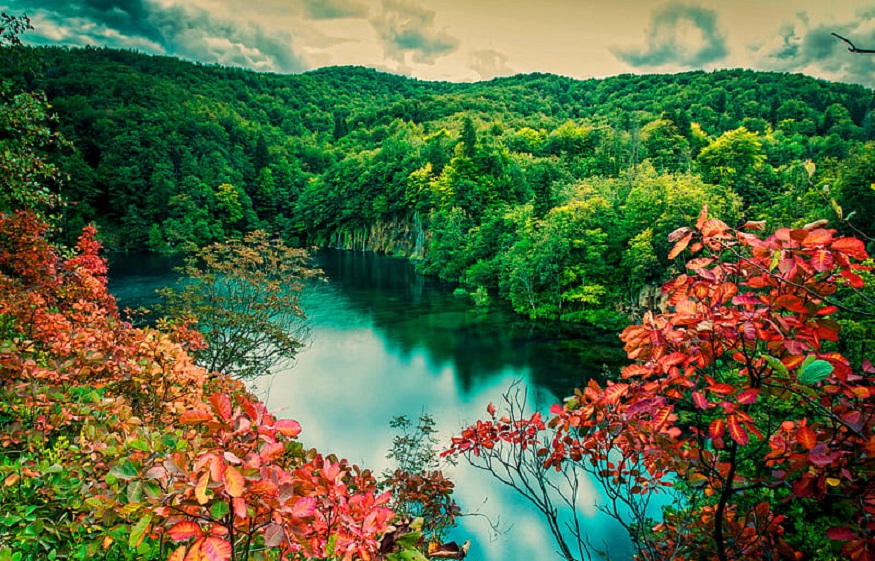The Semois is a tributary of the Meuse that flows gracefully with many large loops along the most beautiful valleys and villages of the Ardennes. Misty villages and towns such as Bohan, Frahan, Rochehaut and Bouillon have inspired the greatest painters and poets over the centuries to create their most beautiful works. Close to the French border, however, it was less pleasant in the 19th century. At that time this part was known as ‘La vallée des fraudeurs‘. There was a lot of smuggling with tobacco, alcohol, perfume and coffee. The secret routes and the barracks where the shadowy trades were conducted can still be found here.
Also enjoy the Burgundian autumn dishes, the walking routes along gentle slopes, the winking cows and the castles of Herbeumont, Bouillon and Sedan. Discover the Semois Valley on foot or by bike, or experience it all from a kayak.
2. The Rhine Valley, Germany: 67 kilometers of World Heritage
Distance from Utrecht: approx. 325 km
The Oberes Mittelrheintal, between Koblenz and Bingen, is worth 67 kilometers of World Heritage. You will find 101 castles here, both on islands in the Rhine and high on the hills. Hills with many viewpoints and vineyards, which turn beautiful green, yellow and red in autumn. And with romantic wine towns such as Bacharach, Kaub and Sankt Goarshausen, and Germany’s most famous rock: the Lorelei. Legend has it that there sat a beautiful woman who sank ship after ship.
Autumn walking is possible everywhere. The Rheinsteig is a multi-day hiking route along the entire valley, but you can also take the Stadtmauer-Rundwegto do Bacharach, from tower to tower, in two, three hours. Or a part of the Rheinsteig and then by boat or train back to your starting point. Or rent a bicycle and take a romantic Rhine trip, using the ferries. The Rheintrout, the Bacharacher Wildschwein and the local wine taste even better afterwards.
3. The Mullerthal: Little Switzerland in Northern Luxembourg
Distance from Utrecht: approx. 350 km
The Mullerthal (or Mëllerdall), is also known as the ‘Little Switzerland of Luxembourg’. The nature reserve owes this to the undulating, Swiss-looking landscape with bizarre rock formations, dreamy lakes and splashing waterfalls.
The Mullerthal Trail is therefore a tour that has already tempted many mountain sports enthusiasts to hiking, but the less experienced (day) hiker can also easily join. The trail, 112 kilometers long, is divided into three routes of varying difficulty. Along the way, enjoy vistas, ruins and castles (like Beaufort Castle), and 1001 other things, like the mossy bridge over the Schiessentümpel waterfall.
4. Ballons des Vosges Regional Nature Park, France: views of colorful nature
Distance from Utrecht: approx. 560 km
The Vosges massif is the closest mountain area in France from the Netherlands. It’s a popular ski resort in winter, but downright impressive in the colorful fall. The peaks are not the highest in France, but this is more than compensated by the views of the Black Forest, the Swiss Alps and France’s highest mountain: Mont Blanc.
To do this, travel to the Ballons des Vosges Regional Natural Park, in the southern part of the Vosges. In addition to the aforementioned views (including from the 1424 meters Ballon d’Alsace), you will find a wealth of animals and mountain lakes here. Put on your naughty hiking boots and follow the trail of wild deer, lynx and the gray wolf. And visit the auberges and restaurants, for tasty stews of regional products and wine from the region. C’est formidable .
The most beautiful of Alsace
5. National Park Valdehavet, Wadden Sea, Denmark: blue sea and black sun
Distance from Utrecht: approx. 680 km
The Danish part of the Wadden Sea has also been on the Unesco World Heritage List since 2014. In the unique shallow water area, which at times looks like it is studded with diamonds, the tide changes every six hours. Twice a day ebb and flow, as the vital heartbeat for the development of an enormous breeding and resting place for seals and millions of migratory birds.
The gigantic flocks of starlings that rest here every year, dancing in the air, form a spectacular natural phenomenon that you can see especially in spring and autumn. The sky here is so black with starlings that the Danes have called this phenomenon Sort Sol (Black Sun). A ‘solar eclipse’ that you can see and experience for yourself in the South Jutland National Park Valdehavet.
6. Saxon Switzerland National Park, Germany: nature paradise with a top attraction
The National Park Sächsische Schweiz (Saxon Switzerland) is located in the East German state of Saxony, which extends into the Czech Republic. You will find deep ravines, sky-high table mountains and bizarre, fairytale-like rock peaks of sandstone, carved by the Elbe River. At the beginning of the 19th century, the time of Romanticism, artists went in search of the beauty of nature. They found it here, in the rugged Elbe Sandstone Mountains. After 1850 it even became busy, when boats and trains steaming from Dresden could also come here. The top attraction was the Basteibrücke, 76 meters long and only for hikers, high between the rocks.
The golden autumn sun makes the experience even more beautiful. With no less than 1200 kilometers of signposted hiking trails, this protected nature reserve is a true hiking paradise, especially in autumn. With a bit of luck you will spot the (forest) inhabitants along the way: black storks, kingfishers, grass snakes and lynxes. Also beautiful, fun and educational are Königstein Castle, the old town of Pirna or a trip by (rental) bicycle along the Elbe. And while you’re there: Prague and Dresden are not far away.

